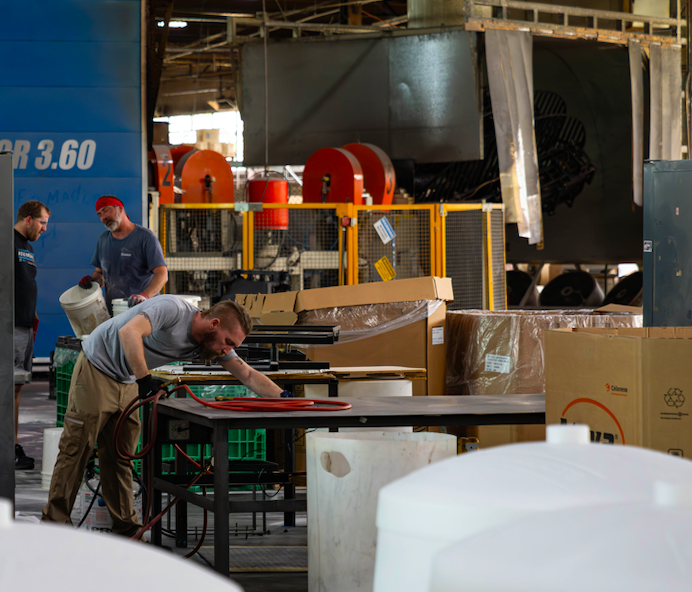Inside the Mold: How Process Control Shapes Quality in Rotational Molding

When it comes to rotational molding, precision isn’t just about geometry; it’s about process. While many people understand the basic steps of rotomolding, fewer realize how much control over heating, cooling, and motion determines a part’s final performance. For engineers and designers, understanding these variables is essential to achieving consistent, high-quality results.
The Four Pillars of Process Control in Rotomolding
- Temperature: Balancing Fusion and Degradation
In rotational molding, temperature governs everything, from how a resin melts to how it crystallizes into its final form. Most polyethylene-based resins require mold wall temperatures between 260°C and 370°C (500°F–700°F), depending on formulation.
- Underheating results in incomplete fusion, leading to weak areas or pinholes.
- Overheating causes degradation, brittleness, and discoloration.
Modern systems often use infrared thermocouples or digital temperature monitoring to maintain tight control throughout each cycle. According to the Association of Rotational Molders (ARM), the use of advanced temperature monitoring has reduced reject rates industrywide by up to 20% compared to manual control.
Temperature management doesn’t just affect surface finish; it directly impacts part strength, dimensional accuracy, and long-term durability.
- Time: Every Second Affects Performance
Rotomolding is deliberately slow, allowing molten resin to flow and coat interior surfaces evenly. But cycle time isn’t one-size-fits-all.
Variables such as part size, wall thickness, and resin type determine how long a mold should remain in each phase.
- Too short, and material may not fully fuse.
- Too long, and excessive oxidation or shrinkage can occur.
Leading manufacturers increasingly rely on data logging to fine-tune cycle durations, improving both repeatability and productivity. In CPI’s own operations (What We Do), precise time and temperature profiling ensures each project meets performance standards without wasted cycles.
- Rotation: Achieving True Uniformity
Rotational molding’s distinctive feature is its biaxial motion, molds spin on two axes simultaneously, typically at speed ratios of 3:1 to 8:1. These parameters determine how evenly the molten plastic coats the mold.
- Too fast, and resin accumulates unevenly, creating thin or voided sections.
- Too slow, and the material pools before melting uniformly.
The ideal rotation ratio depends on geometry. Large, flat surfaces require slower rotation for smooth coating, while cylindrical parts benefit from faster, balanced motion. Proper control ensures uniform wall thickness, a key factor in producing high-quality, durable components.
- Cooling: Where Real Stress Happens
Cooling might appear straightforward, but it’s one of the most technically demanding steps in the process.
As plastic cools, it shrinks, and uneven cooling creates internal stresses that can lead to warping or cracking over time. Cooling too fast increases residual stress; cooling too slowly reduces throughput.
Common approaches include:
- Air cooling which promotes uniform shrinkage and dimensional stability.
- Water mist or spray cooling, which accelerates production cycles.
- Hybrid cooling, balancing quality with efficiency.
A Plastics Technology study found that improved airflow and automated cooling control can reduce cycle times by up to 25%, while maintaining tight tolerances, a significant advantage for large or geometrically complex parts.
Beyond the Basics: Data, Sensors, and Smart Manufacturing
As Industry 4.0 technologies evolve, rotational molding is becoming a data-driven process.
- Embedded temperature sensors inside molds feed real-time data to control systems.
- Predictive modeling helps optimize heating and cooling curves before production begins.
- Digital twins simulate mold behavior under different conditions, identifying optimal parameters for each design.
These technologies reduce waste, improve consistency, and align with sustainability goals — helping manufacturers like CPI advance toward smarter, cleaner production.
For an in-depth reference on the science of process control, Rotational Molding: Design, Materials, Tooling, and Processing from ScienceDirect provides comprehensive technical insights.
Why It Matters for Designers and Engineers
Understanding process control isn’t just the molder’s job, it’s essential knowledge for designers too.
When engineers collaborate early in development, they can design parts that mold efficiently and perform better in the field. Consider these factors:
- Material choice should suit expected thermal cycles and stress conditions.
- Wall thickness should reflect both function and cooling rates.
- Geometry should promote even heat distribution and easy mold release.
This shared awareness reduces redesign cycles, prevents costly tooling changes, and leads to longer-lasting, more reliable products. CPI emphasizes this collaborative approach in every project, part of what sets them apart in the industry (Why CPI).
The Takeaway
Rotational molding may seem simple, add resin, apply heat, spin, and cool, but beneath that simplicity lies a precise dance of physics and control. Managing those variables is what separates a rough prototype from a part that performs flawlessly for years.
As rotomolding continues to evolve through digital tools and advanced monitoring, process control remains the foundation of quality, consistency, and performance.
To learn more about how CPI applies precision control in every project, visit the Precision in Rotational Molding feature on our blog.
